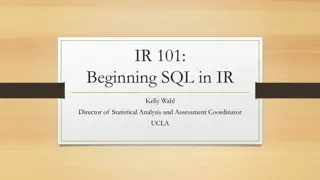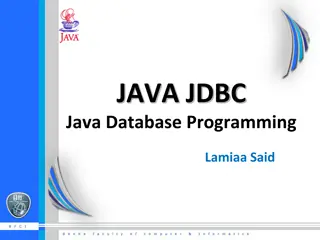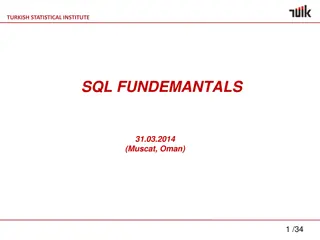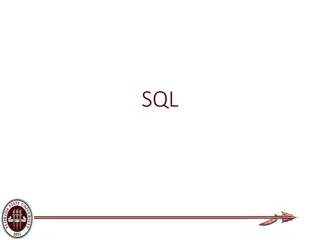
Introduction to SQL Fundamentals: Structured Querying Language for Data Management
SQL, or Structured Querying Language, is a computer language used for relational database management and data manipulation. Unlike other programming languages, SQL focuses on interacting with data through statements like SELECT, CREATE TABLE, and INSERT INTO. This language is essential for working with Database Management Systems (DBMS) like SQL Server, MySQL, Oracle, and IBM DB2. Learn about organizing data in databases, creating entities with tables, and understanding the evolution of data models. Start your journey with problem identification, data structure, and business rules to build effective data models.
Download Presentation

Please find below an Image/Link to download the presentation.
The content on the website is provided AS IS for your information and personal use only. It may not be sold, licensed, or shared on other websites without obtaining consent from the author. If you encounter any issues during the download, it is possible that the publisher has removed the file from their server.
You are allowed to download the files provided on this website for personal or commercial use, subject to the condition that they are used lawfully. All files are the property of their respective owners.
The content on the website is provided AS IS for your information and personal use only. It may not be sold, licensed, or shared on other websites without obtaining consent from the author.
E N D
Presentation Transcript
SQL FUNDAMENTALS - CDSE Days 2018 1
What is SQL? Structured Querying Language computer language for relational database management and data manipulation Sequel Cannot write complete applications All about the data - Read Write Update 2
SQL Syntax Unlike other languages there are multiple variations DataBase Management Systems (DBMS) SQL Server MySQL Microsoft SQL Server Oracle (IBM DB2) - 3
Database A container of organized data that is related Tables: a structured list of data Columns: single fields in a table Rows: a record in a table - 4
Data Models Each table represents an entity and is related to other through a common field (key). - From: https://github.com/talhafazal 5
ERD Example - 7
Evolution of Data Models Data models have evolved with data growth - 8 From: University of California, Davis Extension Sadie St. Lawrence
Where to Start? Problem Identification Data Structure Business Rules - The Data Model is a great starting point 10
SELECT STATEMENT The SELECT statement has 2 components: - What you want - Where to get it - SELECT population FROM world; 11
SELECT STATEMENT Results can be expanded or restricted: SELECT name, population - FROM world WHEREcontinent = Europe ; 12
Creating your own tables The CREATE TABLE statement is used to create new tables in a database. CREATE TABLE games - ( yr INT NOT NULL PRIMARY KEY, city VARCHAR(20) NOT NULL, ); 13
Creating your own tables The INSERT INTO statement is used to populate those tables INSERT INTO games(yr,city) VALUES (2004,'Athens'); - INSERT INTO games(yr,city) VALUES (2008,'Beijing'); INSERT INTO games(yr,city) VALUES (2012,'London'); SELECT * FROM games; 14
Comments Adding comments to code is a fundamental element of good programming practices. /* SQL Comments are enclosed in */ - /* This table is being created as an example */ CREATE TABLE games( yr INT NOT NULL city VARCHAR(20) NOT NULL, ); PRIMARY KEY, 15
WHERE Clause The WHERE clause allows us to be specific in our queries, reducing the number of records retrieved. This clause allows the use of OPERATORS to further restrict the results - SELECT name, population FROM world WHERE population BETWEEN 10000000 AND 12000000; 16
Operator Description Equal = Not Equal (Some SQL variations use !=) < > Greater Than > Less Than < Greater Than or Equal > = - Less Than or Equal < = Between an inclusive range BETWEEN Is a null value IS NULL Specifies a range of conditions IN Avoids evaluating a 2nd condition if the 1st is met OR Can be used with other operators AND Excludes results NOT 17
Wildcards SQL uses * as a wildcard: SELECT * FROM world; Other wildcards are used with a LIKE operator and include: - % (perc%) _ (under _) SELECT name, population FROM world WHERE name LIKE 'P%'; 18
ORDER BY Using the ORDER BY clause allows us to sort data, and can be used with columns that are not retrieved. This clause is always the last one in a SELECT statement. - SELECT name, population FROM world WHERE name LIKE 'P%' ORDER BY population ASC; 19
Mathematical operators Mathematical operators allow you to compute fields that are not included in your saved data. - SELECT name, population, gdp/population AS gdp_per_capita FROM world WHERE name LIKE 'P%' ORDER BY 3 ASC; 20
Aggregate Functions Aggregate functions are used to summarize data, and use descriptive statistics measures. Function Description Averages a column of values Counts the number of values Finds the minimum value in a range Find the maximum value in a range Sums the column values Can be used with some aggregate functions - AVG ( ) COUNT ( ) MIN ( ) MAX ( ) SUM ( ) DISTNCT SELECT COUNT (DISTINCT city) FROM games; 21
Grouping Data SQL allows us to group data and summarize subsets of data: GROUP BY clause - SELECT continent, COUNT(name) as Total_Countries FROM world GROUP BY continent; 22
Grouping Data To filter data that is already grouped the HAVING clause must be used (instead of the WHERE clause) - SELECT continent, COUNT(name) as Total_Countries FROM world GROUP BY continent HAVING COUNT (name) >15; 23
Nesting Queries Queries can be combined, to generate more restricted sets of results. SELECT name, gdp FROM world - WHERE gdp > (SELECT gdp FROM world WHERE name='Portugal') ORDER BY gdp ASC; 24
Example List the name of countries in the continents containing either Argentina or Australia. Order by the name of the country. - SELECT name, continent FROM world WHERE continent IN (SELECT continent FROM world WHERE name IN ('Argentina', 'Australia')) ORDER BY name ASC; 25
Example Germany (population 80 million) has the largest population of the countries in Europe. Portugal (population 10.5 million) has 13% of the population of Germany. Show the name and the population of each country in Europe. Show the population as A percentage of the population of Germany - SELECT name, CONCAT(ROUND(100*population/(SELECT population FROM world '%') AS pop_percent WHERE name = 'Germany')), FROM world WHERE continent = 'Europe' ORDER BY name DESC; 26
Nesting queries Best Practices No limit to the number of subqueries that you can have Performance is affected with deeply nested statements Coding format is important Notepad ++ www.poorsql.com commenting - 27
String Functions Concatenation SELECT CONCAT(name,', ', continent) FROM world; - 28
String Functions Trimming spaces SELECT CONCAT(name,', ', SUBSTR(continent,1,3)) FROM world; - 29
Resources https://sqlzoo.net https://www.w3schools.com/ - 30






















